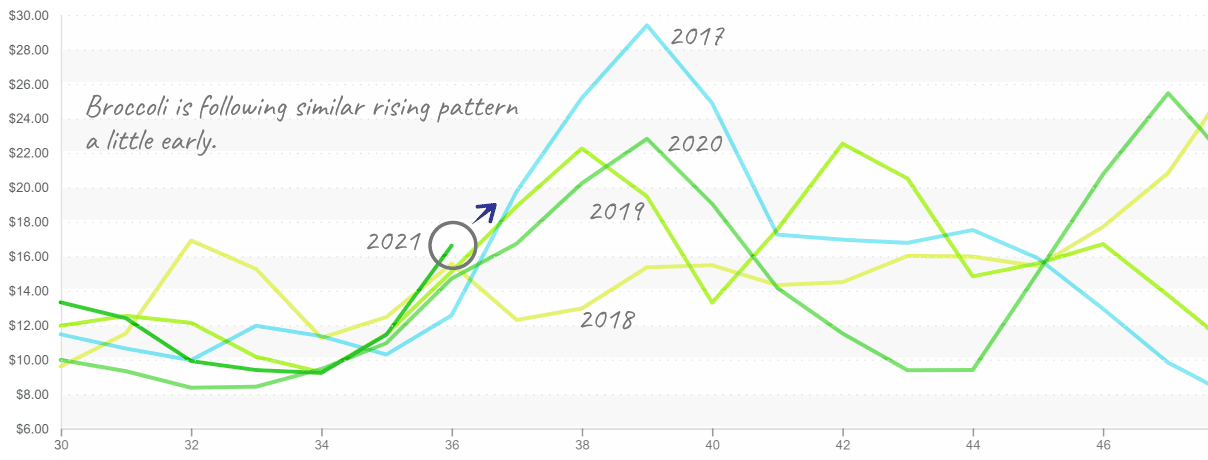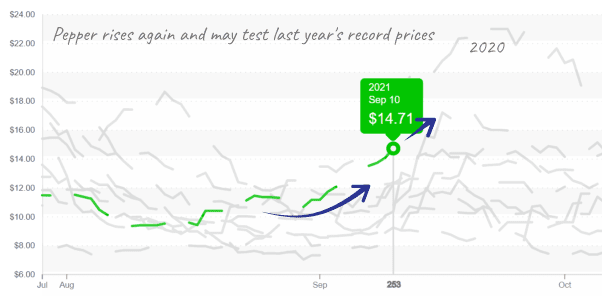Fall is in the air! The fresh produce industry is humming as the first day of fall rapidly approaches (at least for us plan-two-weeks-ahead produce folks). Demand is increasing for seasonal items, such as pumpkins, hard squash and apples.
And if leaves turning colors and cooling temperatures aren’t quite your thing, cough…cough…Florida, at least the fresh produce industry’s biggest event, PMA Fresh Summit, is on the horizon.
Of course, that’s if Ida’s impact on New Orleans and the Delta Variant doesn’t dampen our spirits first. Friendly bets are being placed about whether early marketing efforts towards the big event will have been in vain.
Supply challenges, including harvest transitions, are driving up overall industry prices. Western produce is reeling from the extreme heat, and Eastern produce is recovering from torrential rains.
Eastern harvest regions are also returning to Georgia as the dispersed local summer harvest winds down.
ProduceIQ Index: $1.12/pound, +0.9 percent over prior week
Week #36, ending September 10th
Blue Book has teamed with ProduceIQ BB #:368175 to bring the ProduceIQ Index to its readers. The index provides a produce industry price benchmark using 40 top commodities to provide data for decision making.

At $1.12 per pound, industry prices are at the high end of 10 years of historical prices.
With only a few exceptions, Western vegetable and lettuce prices are rapidly swelling as the fresh produce industry enters week #36. Major price increases by cauliflower, broccoli, and iceberg lettuce exceed 30 percent.
Cauliflower is up 42 percent from week #34 prices. Prices are within the bounds of historical precedent, however, fall demand is bringing optimism to a struggling supply, moving prices off a $7 floor to $12. Expect markets to climb higher as growers battle heat-related damage and transitioning growing regions destabilize supply.
Picky eaters are astounded as broccoli prices double from $9 to $18 within two weeks. Extreme heat is decreasing yields in an already limited market. Expect prices to remain elevated throughout September.

Broccoli prices spike this time of year.
Demand is outpacing supply, pushing Brussels sprout prices into the 2nd highest prices in the past 10 years. Prices reached $35 last week but couldn’t hold and began a descent. Year 2017 was an anomaly when prices reached $57/case. Growers are reporting a slowly improving supply, but oxidation and insect damage are hindering progress.
Both iceberg and romaine lettuce are up double digits. Heat-related damage and subsequent quality issues will persist as long as temperatures remain elevated. Markets will remain unhinged as growing regions finish in California and pick up again in Yuma, AZ.
Despite rain from Ida, squash markets are down -20 percent over the previous week. Decreasing demand, coupled with optimism for Mexican squash to start crossing through Nogales, is keeping prices modest.
The aftermath of Ida’s heavy rains more heavily affected bell peppers. Prices are up 23 percent, to $15 per case, over the previous week. Rain from Ida damaged waning supply, leaving Eastern quality sporadic depending on the particular field.
In the West, green and red supply is decreasing due to seasonal transition. Expect western quality to be good, yet supply to remain tight, until new growing regions ramp up.

Green bell pepper markets are active as Eastern quality is suspect and harvesting transitions back to Georgia.
Please visit our online marketplace here and enjoy free access to our market tools which created the graphs above.
The ProduceIQ Index is the fresh produce industry’s only shipping point price index. It represents the industry-wide price per pound at the location of packing for domestic produce, and at the port of U.S. entry for imported produce.
ProduceIQ uses 40 top commodities to represent the industry. The Index weights each commodity dynamically, by season, as a function of the weekly 5-year rolling average Sales. Sales are calculated using the USDA’s Agricultural Marketing Service for movement and price data. The Index serves as a fair benchmark for industry price performance.



